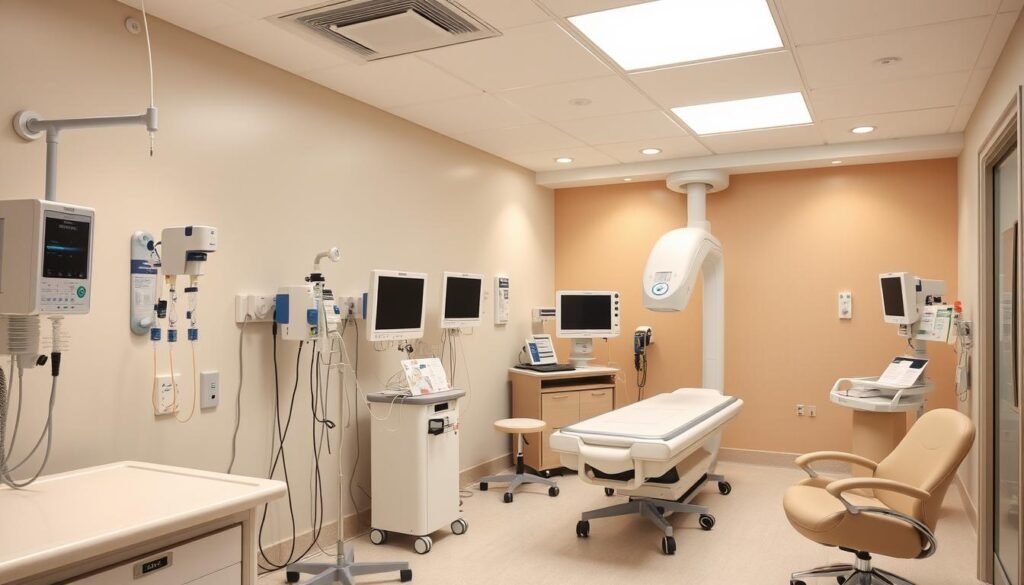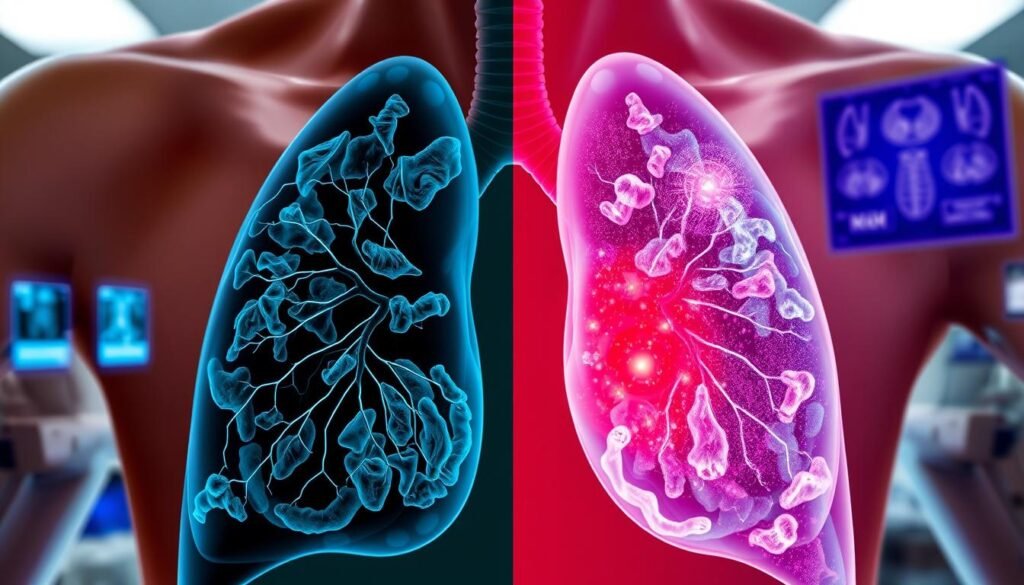Did you know that lung cancer survival rates have gone up to 28.4%? That’s a 26% increase in the last five years. This shows that there is hope for people with lung cancer. As medical treatments get better, patients have more options to fight lung cancer. It’s not just about numbers. It’s about the lives of people and how new medical treatments help them. We will talk about lung cancer survival rates, treatment choices, and why finding cancer early is so important. Patients and their families can learn a lot from this.
Key Takeaways
- The national lung cancer survival rate improved to 28.4% in the past five years.
- Only 16% of eligible individuals were screened for lung cancer in 2022.
- Lung cancer screening could reduce mortality by up to 20% and save 80,000 years of life.
- Localized lung cancer shows a five-year survival rate of about 62.8%.
- The prognosis for lung cancer varies based on the type, stage, age, and overall health.
- Early detection significantly expands treatment options for patients.
- Advancements in treatment are enhancing the quality of life for lung cancer patients.
Understanding Lung Cancer Survival Rates
Lung cancer survival rates give us important clues about the disease. They show the chances of surviving over five years based on factors like cancer stage and treatment. This information helps patients and their families handle a lung cancer diagnosis.
Five-Year Relative Survival Rates
The five-year survival rates for different stages of non-small cell lung cancer (NSCLC) are shown below:
| Cancer Stage | 5-Year Relative Survival Rate |
|---|---|
| Localized | 65% |
| Regional | 37% |
| Distant | 9% |
| All SEER stages combined | 28% |
Small cell lung cancer (SCLC) has lower survival rates:
| Cancer Stage | 5-Year Relative Survival Rate |
|---|---|
| Localized | 30% |
| Regional | 18% |
| Distant | 3% |
| All SEER stages combined | 7% |
These numbers show why detecting lung cancer early is crucial. Early detection can lead to much better outcomes.
Factors Influencing Survival Rates
Many factors affect lung cancer survival rates. Here are a few:
- Cancer Stage: Detecting lung cancer early greatly increases survival chances.
- Cancer Type: Whether lung cancer is NSCLC or SCLC affects survival.
- Overall Health: A patient’s overall health and other conditions affect treatment success.
- Treatment Response: People respond differently to treatments, influencing survival.
Remember, survival rates are estimates, not certain predictions. For a deeper look, check the detailed statistics on lung cancer survival.
Is Lung Cancer Survivable: Hope & Treatment Options
Lung cancer survivability has increased thanks to medical advancements. Nowadays, the overall survival rate is about 28.4%. This shows how new treatment methods help patients and their families have more hope.
Statistics and Progress in Survival Rates
In the last five years, lung cancer survival rates have gone up. This is because of new treatments and lots of research. Even though lung cancer is still the top cancer killer in the U.S., things look better for those with early-stage lung cancer. They have a five-year relative survival rate of 63%. But, survival rates are lower for more advanced stages.
Early detection and better treatments are key to improving survival rates. New therapies and finding specific cancer markers have helped a lot, especially for small cell lung cancer. Stories like Maida Mangiameli’s, who beat small cell lung cancer, show how important hope and fighting spirit are.
New treatments bring more hope to those facing lung cancer. Early diagnosis leads to much better survival chances. This makes us think that lung cancer can be beaten as treatments keep getting better. For more on early-stage lung cancer, visit is lung cancer survivable.

Stages of Lung Cancer: An Overview
It’s crucial to know the stages of lung cancer to plan treatments and understand prognosis. Lung cancer has three main stages: localized, regional, and distant. Each stage has its own traits and impacts on patient care, especially in terms of treatment choices and survival chances.
Localized, Regional, and Distant Stages
Localized lung cancer is when the cancer is only in the lungs. This stage has more treatment options and generally means a better outlook. For localized lung adenocarcinoma, the five-year survival rate is 73.3%. Sadly, only about 26% of lung cancers are found at this early stage, showing the need for early detection.
Regional lung cancer means the cancer has spread to nearby areas or lymph nodes but not far away places. Treatment is still possible, but survival rates are a bit lower than in localized cases.
Distant lung cancer is when the cancer has spread to other parts of the body. This advanced stage makes treatment more complicated, and survival rates vary. Shockingly, up to 55% of people with non-small cell lung cancer are diagnosed at stage four. The five-year survival rate significantly drops at this stage, underscoring the need for better treatment methods and care.
In summary, understanding lung cancer stages helps in making treatment choices and planning care. Early detection and knowing each stage’s impact can improve chances of survival and lead to better health outcomes.
Lung Cancer Treatment Options Available
Lung cancer treatments include different methods for NSCLC and SCLC. The choice of treatment depends on the cancer stage and type. It also considers the patient’s general health.
Chemotherapy and Radiation Therapy
Chemotherapy is a key lung cancer treatment, usually given through IV infusion. It can shrink tumors before surgery or remove remaining cancer cells afterward. Radiation therapy offers an alternative or additional option. It targets cancer cells directly. Radiofrequency ablation (RFA) is a technique used for NSCLC tumors near the lung surface. It improves localized treatment results.
Targeted Therapy and Immunotherapy
New treatments like targeted therapy and immunotherapy are now available. Targeted therapy attacks lung cancer cells’ genetic mutations. It aims to slow their growth or kill them. Immunotherapy helps the immune system fight cancer. These approaches are especially promising for patients with certain genetic changes. They lead to potentially better outcomes.
Palliative Care Considerations
Palliative care is key for lung cancer patients, focusing on easing symptoms like pain and breathing issues. It improves the patient’s life quality. This care helps manage side effects from other treatments, such as nausea and fatigue. Healthcare teams work with palliative care experts. They help patients handle the effects of treatment better.

| Treatment Type | Indication | Common Side Effects |
|---|---|---|
| Chemotherapy | Used before or after surgery for NSCLC and SCLC | Nausea, vomiting, fatigue, hair loss |
| Radiation Therapy | Can be used alone or in combination with other treatments | Skin irritation, fatigue, shortness of breath |
| Targeted Therapy | Targets specific mutations in NSCLC | Neuropathy, joint pain |
| Immunotherapy | Enhances the immune system’s ability to fight cancer | Flu-like symptoms, fatigue |
| Palliative Care | Focuses on symptom relief and quality of life | Varies based on individual conditions |
Importance of Early Detection in Lung Cancer
Finding lung cancer early is key to better treatment and longer life. If you’ve smoked a lot, getting checked regularly can really help catch cancer early. This is when it’s easier to treat. The U.S. Preventive Services Task Force recommends yearly scans for people 50 to 80 years old who have smoked a lot.
Lung Cancer Screening Guidelines
Screening guidelines target those most at risk. If you’re 50 to 80 and smoked heavily for many years, you should get checked every year. This is especially true if you’re still smoking or quit in the last 15 years. Low-dose CT scans can lower death rates by about 20% compared to old-school chest X-rays.
Benefits of Early Detection
The upside of finding lung cancer early is huge. It makes beating cancer more likely and can greatly improve survival rates. For instance, catching lung cancer at stage IA means over 90% of people can live more than five years. That drops to less than 10% at stage IV.
Regular checks can catch cancer early. This can mean an 81% chance of surviving 10 years after early CT screening. Catching it early not only saves lives but also cuts down on treatment costs and improves life quality.

Knowing the screening rules and how vital early detection is matters a lot. If you’re at risk, talk to your doctor. Together, you can figure out the best way to keep an eye on your health.
Common Lung Cancer Symptoms to Watch For
Spotting lung cancer signs early can greatly improve treatment success. Often, people don’t see symptoms until it’s advanced. Yet, some early signs can appear, increasing the chances of beating the disease. It’s crucial to know these signs to seek help early and possibly improve health outcomes.
Recognizing Symptoms at Different Stages
The symptoms of lung cancer can change depending on how far the disease has progressed. Typical signs of lung cancer include:
- Coughing that does not go away
- Chest pain or discomfort
- Hoarseness
- Unexplained weight loss
- Shortness of breath
- Fatigue
- Frequent infections
As lung cancer grows, it’s vital to notice symptoms like bone pain, changes in the nervous system, jaundice, and enlarged lymph nodes. Pancoast tumors may cause symptoms such as drooping eyelids and changes in pupil size. Symptoms like swelling in the face, neck, and arms, along with headaches and breathing issues, could indicate Superior vena cava syndrome. If the nervous or endocrine systems are affected by Paraneoplastic syndromes, it could lead to muscle weakness and memory problems. Catching these signs early can help you talk to your doctor for the right tests and diagnosis.
When to Seek Medical Evaluation
It’s important to see a doctor at the right time. If you notice constant health changes or any listed symptoms, it’s time to get checked. Because lung cancer can be deadly, knowing when to get help is key to managing your health.
Being aware of symptoms and talking to a doctor about health changes can help catch lung cancer early. Early discovery makes successful treatment more likely. Always be ready to reach out to your doctor with any worrying or strange symptoms.
Lung Cancer Risk Factors: What You Should Know
Lung cancer risk factors are key to understanding threats to lung health. Smoking is a big contributor, linked to around 90% of lung cancer cases. Both smokers and those exposed to secondhand smoke are at a higher risk. Knowing about environmental and lifestyle factors can help people make better health choices.
Smoking and Environmental Exposures
Smoking is the top cause of lung cancer. Heavy smokers especially risk getting small cell lung cancer. Other dangers include radon gas and workplace carcinogens. It’s crucial to test homes for radon, avoid harmful substances at work, and keep environments smoke-free. Learn more about specific lung cancer risks to understand what you can control and how to lessen these risks.
Genetic and Familial Influences
Genetics also matter in lung cancer risk, along with environmental dangers. Having lung cancer in the family means a higher risk. It’s wise to know your family’s lung cancer history and talk to doctors about it. Early awareness and checks are key, especially if you have known risks.
Living a healthy life helps too. This means eating well and exercising often. Quitting smoking greatly lowers lung cancer risk. Support and quitting aids are crucial for those trying to quit. Being aware of both lifestyle and genetic factors lets people make smart health decisions.
Lung Cancer Prognosis: A Glimpse into Outcomes
Lung cancer outcomes can be different for each patient. This depends mostly on the cancer stage when it’s found. Early detection, when the cancer is still localized, usually gives a better chance of survival. In fact, the five-year survival rate for localized lung cancer is about 63.7%. This shows how vital it is to catch the disease early.
Understanding Prognosis Based on Stages
Survival rates for lung cancer change with each stage of the disease. Here’s a quick look at these rates:
| Stage | Five-Year Relative Survival Rate |
|---|---|
| Localized | 63.7% |
| Regional | 34.5% |
| Distant | 7.5% |
These numbers show why knowing the cancer’s stage helps in understanding prognosis. While the general five-year survival rate for lung cancer is 26.7%, localized stages have much better chances.
The Role of Personal Health Factors
Many personal factors affect lung cancer survival. Age, general health, and the tumor’s size and type are key. Adenocarcinoma patients often have a better outlook, usually because they are younger and have smaller tumors.
Squamous cell carcinoma patients, in comparison, face different challenges. Plus, tumors smaller than 2 cm are linked with better survival rates. This underscores how complex understanding prognosis can be.
Thus, both the disease’s stage when diagnosed and the patient’s overall health matter greatly. This underscores the need for care plans that cater to the individual.
Conclusion
Lung cancer is tough, but there’s good news. New treatments bring hope. Now, the survival rate for all types is 19% over five years. For non-small cell lung cancer (NSCLC), it’s even better at 23%. This shows we’re making progress in helping people live longer, better lives.
It’s super important to catch lung cancer early. Knowing the symptoms and getting screened makes a big difference. As we discover more treatments, those with lung cancer and their families have reasons to be hopeful. Mortality rates have dropped—48% for men and 23% for women. This shows our treatments are working.
Learning about lung health is key. The more you know about lung cancer risks and new treatments, the better you can look after your health. This helps build a community that supports each other. By talking and making informed choices, we can help everyone facing lung cancer.